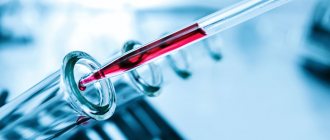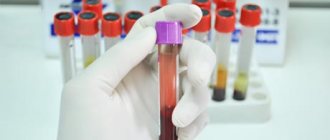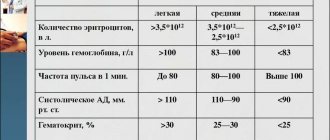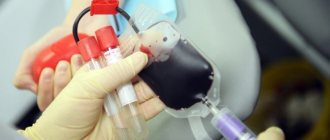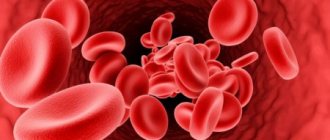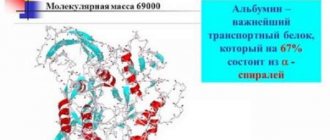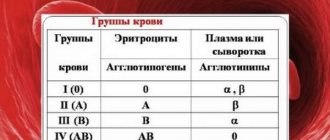AST and ALT
What is AST
AST is aspartate aminotransferase. It is a protein synthesized by the soft tissues of some internal organs. In particular, it is produced in the heart, kidneys, liver, pancreas and other organs.
AST belongs to the intracellular enzymes of the transaminase group. One of the main components of protein is vitamin B6. This substance takes an active part in amino acid metabolism. During the metabolism of AST, substances arise that are responsible for the synthesis of sugar.
The enzyme provides a boost of energy when a child plays sports or has to go without food for some time.
AST in children stimulates important biochemical processes. An excess of this protein indicates that some pathology may develop in the body. Most often, an increase in the enzyme indicates diseases of the heart, pancreas and other organs. For this reason, if AST is elevated in a child, you should consult a doctor to determine the cause and prescribe appropriate therapy.
What is ALT
ALT is alanine aminotransferase. It is an intracellular enzyme. The main part of the protein is synthesized by the soft tissues of the liver. Small amounts are produced in the heart, kidneys and muscle tissue.
A change in the level of the enzyme in the blood indicates problems with the liver.
Increased AST in a child: causes and should you worry
What to do if AST is elevated in a child? In such cases, specialists conduct a complete diagnosis of the health status of the small patient.
A biochemical analysis, during which the level of aspartate aminotransferase is determined, makes it possible to detect diseases of the muscles, liver and myocardium at the very beginning of the development.
Most often, the study is carried out simultaneously with determining the amount of bilirubin and ALT in the blood.
In the case where the decoding of the data indicates an excessively high amount of AST, the doctor can make a diagnosis and discover in which organ the problem exists.
Identification of the indicator
Using centrifugation, the plasma is separated from the formed element, after which a chemical reaction occurs that determines how active aspartate aminotransferase is in the blood system.
The result is always ready within two days. The results are deciphered only by specialists in this field who know the norms of laboratory research.
Each laboratory uses the technique differently due to different reagents and application methods.
Preparation for the study: to get reliable results, you must undergo the procedure in the morning on an empty stomach. It is not recommended to eat food 9 hours before the procedure.
In addition, the day before the procedure you should not drink alcohol, fatty and fried foods, sweets, and baked goods. Also limit the use of physical and mental stress.
You should stop taking medications several weeks before the procedure.
The specialist should be warned about this; if the medication cannot be stopped, the study will be postponed until treatment is stopped, since these drugs may affect the detection of the result.
You should also tell your doctor if you have any allergic reactions or if you are pregnant. After undergoing examinations in the form of ultrasound, fluorography, and physiotherapy, the procedure is excluded.
The use of medications may affect the change in results. As a rule, it is necessary to warn the doctor in advance about the use of a particular drug. Usually, the specialist recommends stopping the drug a couple of days before the procedure. The exception is when the drug is vital.
This also happens when herbal remedies and medicinal herbs are used. Taking large doses of vitamins, especially A, B, C, and recent surgery or catheterization have an effect.
ALT norm in children: the norms for the quantitative level of AST are in children after 9 years of age no more than fifty units per liter, in newborns no more than one hundred.
Folk remedies to lower the level of indicators
The changes are minor, but ALT and AST are still increased. What this means in a particular case will be revealed by additional research. Treatment with folk remedies should not replace medications and medical supervision.
However, there are decoctions and infusions, the use of which, with a slight increase, normalizes the functioning of internal organs and lowers the level of aminotransferases:
- Herbal infusion for liver pathologies. Mix and grind 20 g of celandine, 40 g of immortelle, 40 g of St. John's wort. Pour into a thermos, add 1.5 liters. water brought to a boil. Ready for use after 12 hours. Drink 4 times a day for 2 weeks. The infusion promotes the regeneration of liver cells.
- Infusion for heart disease. For a glass of boiling water 1 tsp. adonis. Leave in a warm place for 2 hours. Take 1 tbsp on an empty stomach. l. several spoons a day for 2 weeks.
- Dandelion infusion. In a container of 0.5 l. Place flowers, pour 150 ml. vodka. Take 2 tbsp every 24 hours. l. 3 times. Duration of treatment is 2 – 3 weeks.
- Milk thistle infusion. Grind the seeds, brew 1 tsp. for 250 ml. Leave in a warm place for 20 minutes. Strain. Drink 3 weeks 2 times a day 30 minutes before meals. Drink the decoction slowly. Indications: hepatitis, liver disease.
- Corn decoction. Dry and grind the corn hairs. 1 tsp. 200 ml. boiling water Let it brew for 15 minutes. Take 1 glass 2 times a day for 3 weeks.
Standards and deviations from the level
The norm of ALT and AST in children: If the norm increases or decreases, this means a deviation and that a system failure has occurred in the body.
This technique is carried out to check the liver for damage, as well as to detect serious diseases such as hepatitis and cirrhosis of the liver. Also, using the procedure, they find out the reason for the formation of jaundice.
They check whether the treatment is effective, evaluate the effect of medications on the liver that can worsen its condition, and also diagnose heart disease.
Using an AST analysis, cytolysis is determined, the processes in which cells, heart muscle and liver are destroyed. When there is damage in other organs, but this parameter is not observed to increase. The main goal of the procedure is to detect damage in specific tissues. They also carry out differential diagnosis and exclude the development of diseases in the cardiac system and liver.
AST is a class of aminotransferases - these are enzymes that participate in the breakdown of amino acids. This phase occurs in many organs in the body. The AST level is determined in the morning, blood is taken from a vein.
Increased AST in a child: the main factors used to determine the level of AST in the blood system are diagnosing the condition of the heart muscle, determining the pathological process in the skeletal muscles, and identifying the functioning of the liver. An increase in the level of AST is detected in various clinical situations.
This happens when the extrahepatic bile ducts are blocked by tumor formations due to stones, parasites, and helminths
Increases in AST indicator: this is a transient indicator of the concentration level of this enzyme in the blood system, which rapidly returns to its normal limits.
With a hundredfold increase in AST levels, which is characteristic of pathological processes, rapid lesions occur in the parenchymal system, and intracellular enzymes enter the blood system.
An example of this process is viral hepatitis, which has a high degree of activity.
Alanine aminotransferase and aspartate aminotransferase are increased, what does this mean?
Alanine aminotransferase (ALT, AlAT) and aspartate aminotransferase (AST, AST) are a group of important enzymes (natural catalysts for chemical reactions) of the human body, belonging to the class of aminotransferases. These substances do important work and participate in amino acid metabolism reactions.
ALT catalyzes the reaction of transferring the amino group of alanine to alpha ketoglutaric acid to form pyruvic acid. AST accelerates the reaction of the transfer of the amino group of aspargine to alpha ketoglutaric acid with the formation of oxaloacetic and glutamic acids.
Both of these reactions occur with the participation of the vitamin B6 derivative coenzyme peroxal phosphate.
Alanine aminotransferase and aspartate aminotransferase are localized in many tissues of the human body.
Their predominant amount is concentrated in the cells of the liver and kidneys, a small amount is observed in the cells of the muscles and heart. By exceeding the test values, one can draw conclusions in which organ cell destruction occurred with the release of aminotransferases.
During a biochemical blood test, tests are done for each of the aminotransferases to determine their independent indicator, and tests are also done for their ratio in the blood. This ratio is called the de Ritis ratio (DRr). This coefficient is determined by the formula DRr = AST / AlAT.
In combination with these tests, tests are done for the content of bilirubin - a breakdown product of hemoglobin.
The level of aminotransferases in the blood depends on the age and gender of the person. Table 1 shows the reference values for alanine aminotransferase and aspartate aminotransferase.
Table 1. Norm of analysis for aminotransferases in the blood.
The norm of the de Ritis coefficient ranges from 0.91 to 1.75.
Source: https://klinika-krovi.ru/krov/ast-povyshen-u-rebenka-prichiny.html
Indications for analysis
An analysis of AST levels is prescribed by a specialist in the following cases:
- Suspicion of heart pathology;
- Muscle dysfunction;
- To determine the condition of the liver and its capacity;
- Kidney pathologies;
- Diseases the appearance of which is caused by infections;
- Encephalopathy of unknown origin;
- Autoimmune pathologies;
- Jaundice and diseases associated with impaired bilirubin production;
- Chronic pancreatitis;
- Purulent-septic diseases;
- Gallbladder diseases;
- Diseases of the endocrine system;
- Oncological pathologies in a malignant form;
- Atypical reactions of the body to exposure to allergens, resulting in diseases of the epidermis;
- Muscle tissue injuries;
- Preparation for surgery;
- During therapy to assess the effectiveness of treatment.
An ALT test is prescribed if there is a suspicion of liver pathology. In this case, the following symptoms arise:
- Abdominal pain localized in the right hypochondrium;
- Change in color of the epidermis and whites of the eyes to a yellow tint;
- Bitterness in the mouth;
- Nausea accompanied by vomiting;
- Increased body temperature;
- The child gets tired quickly and eats poorly.
What is AST and what is its role in the body
Aspartate aminotransferase is a transporter of amino acids that are formed after the breakdown of proteins. Thanks to them, the broken down proteins can be used for the body's needs. Transaminases are involved in the process of gluconeogenesis - the synthesis of the main source of energy in “hard times” (during fasting, exercise, exhaustion). The need for the formation of glucose from alternative sources (proteins and fats) also arises in some endocrine disorders.
AST is present in all cells of the body. The largest amounts are found in the heart muscle, slightly lower concentrations are concentrated in the liver and skeletal muscles. AST is also detected in the kidneys, pancreas, spleen, and brain. The enzyme is present even in blood cells - erythrocytes, and circulates in minimal doses in the blood plasma.
AST activity increases if the enzyme enters the bloodstream from destroyed tissue. The source of the substance can be cells in which its concentration is high, that is, an increase in ALT levels always indicates the destruction of certain organs.
The enzyme is considered a marker of damage to the liver and myocardium (changes in these organs primarily affect the results of biochemistry). However, doctors believe that the enzyme can be considered an indicator of necrotic processes in general. A blood test for AST is prescribed for:
- diagnosis of liver pathologies;
- autoimmune processes;
- endocrine diseases;
- infections;
- oncopathology;
- detection of purulent-septic changes;
- control the development of encephalopathy;
- assessing the severity of chest and abdominal injuries;
- monitoring the course of cholelithiasis;
- preparation for surgery;
- control of chronic and acute pathologies of the heart and other internal organs.
AST is regularly checked if the patient is being treated with drugs with hepatotoxic properties. Using the indicator, you can adjust the dose to the minimum effective, preventing severe side effects.
Blood biochemistry is prescribed to patients who have nonspecific symptoms of the disease in order to determine the localization of the pathological process and exclude damage to vital organs.
Alarming signals from the body can be considered fatigue, weakness, drowsiness, sudden changes in body weight, dull pain in the abdomen, digestive disorders, periodic stool disorders, nausea, vomiting. Signs of jaundice are considered a direct indication for studying liver function:
- icterus sclera;
- yellowing of the skin and mucous membranes;
- darkening of urine;
- stool discoloration;
- pain in the right hypochondrium;
- a feeling of bitterness in the mouth;
- frequent belching of air;
- bloating;
- constipation or diarrhea.
Persons at risk who are likely to suffer liver damage are alcohol drinkers, patients who have had infectious hepatitis or have been in contact with patients taking potentially dangerous medications, those with obesity, and diabetes mellitus.
How the research is carried out
The analysis is carried out in laboratory conditions. In older children, biomaterial is taken from a vein, in younger children - from the heel. There are no special rules for testing for infants. Older children are advised to adhere to the following recommendations:
- The biomaterial is taken in the morning on an empty stomach;
- Before the study, the child should be provided with comfortable psychological conditions and reduced physical activity;
- A few days before the analysis, fatty, spicy, smoked and salty foods are removed from the diet;
- A few days before the delivery of the biomaterial, they stop giving the child medications, and if it is not possible to interrupt therapy, a list of medications is presented to the doctor or specialist who will conduct the analysis.
Features of conducting a biochemical blood test
If doctors have prescribed blood biochemistry, parents should prepare their child for the test in advance. You need to go for the procedure in the morning. It is forbidden to feed the baby before this; moreover, the last meal should be 9 hours before handing over the material. You should give up sweets and baked goods during the day, and also limit the load on your body. It is important to stop taking medications for a few weeks because they can distort the result, as is the case with the ALT test.
If the child needs to continue taking medications, the doctor will have to be notified about this. Most likely, he will reschedule the biochemical blood test for another time. You should tell your doctor if you have any allergic reactions or other health problems. Biochemistry cannot be taken after undergoing ultrasound examination, fluorography, or physiotherapeutic procedures.
Otherwise, no additional preparation is required. It is enough to come with your child on the appointed day, making sure that the baby does not suffer from viral pathologies and feels normal. The result will be ready in two days and can only be deciphered by a medical specialist. You can only guess on your own what exactly the indicators mean.
Enzyme standards for children
Each laboratory has its own reference values for this enzyme. Usually they focus on two main units of measurement of protein content in the body - mkat/l and U/l.
In this regard, reference protein values in children will be different.
Table 1. AST norm in children in mkat/l
| Age | Norm, mkat/l |
| Up to 1 month | 0,38-1,21 |
| From 1 to 12 months | 0,27-0,97 |
| From one year to 16 years | 0,10-0,63 |
Table 2. AST norm in children in U/l
| Age | Norm, Units/l |
| Up to 1 month | Up to 73 |
| From 1 to 12 months | Up to 58 |
| From one year to 16 years | Up to 38 |
Based on these reference values, the analysis is deciphered.
ALT also has its own reference values.
Table 3. ALT norm in children
| Age | Norm, units/l |
| Up to 12 months | Up to 60 |
| From 1 year to 3 years | 40-45 |
| From 3 to 6 years | |
| From 6 to 12 years |
Increased asthma in a child: causes and possible diseases
To assess the child's general health, doctors may prescribe a biochemical blood test. If the indicator is elevated, we can assume the presence of pathologies and various malfunctions in the body.
One of the criteria will be AST, and it can be used to judge the health of the liver and other organs. The analysis is prescribed even for small children.
If the results show that AST is elevated in the child, then medical specialists will conduct additional studies and, if necessary, prescribe an examination.
Characteristics of AST and ALT
AST is aspartate aminotransferase, which is a protein. Produced by the soft tissues of the heart, liver, kidneys, and pancreas. Refers to intracellular enzymes belonging to the group of transaminases.
Protein contains an important element - vitamin B6. It is known to be involved in amino acid metabolism. During the metabolism of AST, substances appear that affect the synthesis of glucose.
The enzyme in question provides a boost of energy in situations where children do not eat for a long time or exercise vigorously.
Aspartate aminotransferase is involved in various biochemical processes. Its excess indicates that a person has a disease. It is difficult to say just from the results of a blood test what pathology you are dealing with. Often, an elevated level of this liver enzyme indicates problems with the heart muscle, pancreas and other organs.
ALT may also be elevated in children. We are talking about alanine aminotransferase, which is an intracellular enzyme. Most of the protein is produced by soft hepatocytes. The kidneys, heart and muscle tissue are responsible for the synthesis of the remaining amount. If ALT changes in children, this indicates problems with the liver.
Norm for children
In healthy children, the indicator should be within the normal range, because if it is elevated, this indicates the presence of problems in the body. When deciphering the analysis, doctors take into account the patient’s age, because the numbers change over the years.
AST norm:
- Baby age up to 1 month – from 0.38 to 1.21 mkat/l.
- For a child under 1 year old – from 0.27 to 0.97 mkat/l.
- Patient from 1 year to 16 years – from 0.10 to 0.63 mkat/l.
If AST and ALT are elevated, then you will have to make sure that there are no dangerous diseases.
The analysis result may be indicated in U/l, and in such a situation the indicators will be different:
- For a child up to 1 month – the norm is 73 U/l.
- From 1 to 12 months – up to 58 U/l.
- From one year to 16 years – up to 38 U/l.
If the indicators are slightly elevated, then we can assume that this is the norm for a particular child. With a significant increase, there is a possibility that the body has been affected by pathology. With the help of other examinations you will need to find out what disease you are dealing with.
Features of conducting a biochemical blood test
If doctors have prescribed blood biochemistry, parents should prepare their child for the test in advance. You need to go for the procedure in the morning.
It is forbidden to feed the baby before this; moreover, the last meal should be 9 hours before handing over the material. You should give up sweets and baked goods during the day, and also limit the load on your body.
It is important to stop taking medications for a few weeks because they can distort the result, as is the case with the ALT test.
If the child needs to continue taking medications, the doctor will have to be notified about this. Most likely, he will reschedule the biochemical blood test for another time. You should tell your doctor if you have any allergic reactions or other health problems. Biochemistry cannot be taken after undergoing ultrasound examination, fluorography, or physiotherapeutic procedures.
Otherwise, no additional preparation is required. It is enough to come with your child on the appointed day, making sure that the baby does not suffer from viral pathologies and feels normal. The result will be ready in two days and can only be deciphered by a medical specialist. You can only guess on your own what exactly the indicators mean.
The main reasons for increased AST
The AST score may change in certain situations. Some diseases are life-threatening, so if this indicator is elevated, this cannot be ignored.
Various reasons:
- Blockage of the biliary tract. This is observed with the appearance of tumors, helminthic infestations, and calculi. As soon as the ducts are brought back to normal, the AST indicator returns to normal.
- Severe decrease in blood pressure. The problem occurs with intense bleeding, both external and internal. In addition, the child may have blood poisoning, which is life-threatening. It is necessary to ensure that blood pressure is within normal limits.
- Strong increase in enzyme. This is typical for various pathologies in which the liver parenchyma is observed, as well as the penetration of intracellular enzymes into the blood plasma. We are talking about viral forms of hepatitis, severe damage to the body by toxic substances.
- Hepatitis. It can be of different types - acute, toxic, chronic, infectious.
- Destruction of hepatocytes. A similar phenomenon is observed in various diseases and provokes an increase in AST in a child.
- Muscle tissue dystrophy.
- Myocarditis.
- Pancreatitis. When it becomes acute, the indicator in question may be increased.
- Hemolytic type anemia.
Parents often ask whether they should worry and go to the doctor if AST increases. Medical experts recommend taking additional tests to understand whether bilirubin, GGTP, and alkaline phosphatase are normal. It is necessary to check the condition in the liver, since most often pathological processes take place there. Tests should be taken to determine the presence of hepatitis.
Children have poor health and are vulnerable to many diseases. It is important to identify any deviations in a timely manner in order to understand exactly how to proceed. There are situations when AST is elevated, but there are no dangerous diseases.
For example, the baby recently suffered from an acute respiratory viral infection or the flu, so there are deviations. The child is still recovering, and the parents rushed the biochemistry.
When the consequences of the infection completely disappear, AST will return to normal on its own.
In any case, it is necessary to check why the results of the biochemical study cannot be called satisfactory. Violations may indicate the presence of cardiac, endocrine, hematological and many other pathologies.
In the worst case, cancer can be suspected, so it is important to undergo additional tests in a timely manner. You can’t guess what triggered the alarming sign, since most diseases are successfully treated only in the early stages.
In what cases can the analysis result be distorted?
If AST is elevated, it can suggest not only a disease, but also an incorrect test. In this case, doctors will not detect any symptoms of pathology, so they will advise you to donate blood again.
Sometimes the new results are positive, meaning the person no longer has an elevated AST.
There are some factors that can distort the results of biochemistry, and this must be taken into account before visiting the hospital.
Main reasons:
- Pregnancy period. At this time, the functioning of internal organs changes, so AST may be increased.
- Allergic reaction. The stronger it is, the higher the likelihood of encountering deviations in the results of biochemical analysis.
- A large amount of vitamin A in the body.
- Use of herbal remedies. Even if a person has taken valerian or echinacea, they may experience AST dysfunction.
- Taking medications. Some medications can cause the patient's blood composition to change. Often, the doctor prohibits the use of medications for at least a week before the test. If medications are vital, then the study will have to be rescheduled.
If a person has had a chest x-ray, undergone an ultrasound and rectal examination, or attended physical therapy, then there is no need to donate blood for a test for several hours. Otherwise, you may encounter distorted results, due to which you will then have to undergo additional examinations.
How is blood taken for AST?
A blood test is carried out in a standard sequence, like any biochemical study. Doctors take material only from a vein, because a finger is not suitable. The collection is carried out in the early morning, when the person has not eaten anything.
The nurse will be sure to apply a tourniquet in the area just above the elbow. After this, he will insert a needle into the vein and take up to 20 ml of blood. The tourniquet can then be removed, and cotton wool will need to be applied to the injection site.
A medical specialist will advise you to bend your elbow and firmly press the cotton wool with your hand. This is required to stop minor bleeding. A person should sit for about 5 minutes so that after the procedure the eyes do not darken.
If he feels well, then he can go home.
The collected blood is sent for examination, where plasma will be detected using a centrifuge. The laboratory technician will observe chemical reactions and also determine the AST value. Results are issued in 1-2 days. The attending physician will decipher them.
Reasons for increasing enzyme concentrations
An increase in ALT and AST in a child occurs in most cases when a pathological process develops in the body.
An increase in AST concentration occurs for the following reasons:
- Blockage of the bile ducts;
- Blood diseases;
- Pathologies of a rheumatological nature;
- Oncological pathologies in a malignant form;
- Heart diseases;
- Inflammation that occurs in muscle tissue;
- Intoxication of the liver and pathologies of this internal organ;
- Poor blood supply to the liver;
- Gastrointestinal diseases;
- Genetic pathology associated with poor copper metabolism;
- Thyroid diseases.
ALT concentration increases in the following situations:
- Almost all forms of hepatitis;
- Liver pathologies, including hereditary ones;
- Heavy metal poisoning;
- Oncological diseases of the liver of a malignant nature;
- Inflammation of soft muscle tissue;
- Heart pathologies;
- Blockage of the bile ducts;
- Muscular dystrophy.
An increase in AST and ALT levels also occurs not due to diseases. The reasons for this may be:
- Violation of the rules for submitting biomaterial for research;
- Postoperative period;
- Use of certain medications.
What does an increase in AST mean?
Aspartate aminotransferase is a protein formed in certain types of tissues that activates a number of processes occurring in the body. This is an enzyme belonging to the transaminase subgroup. Most of the protein is found in the cells of the brain, nerve fibers, pancreas, kidneys, lungs, heart and liver.
Vitamin B6 is the main component of this enzyme. It significantly affects amino acid metabolism. During the transformation of AST, substances are formed that allow glucose synthesis to occur. It allows children’s bodies to be in an optimal state for performance under prolonged and heavy loads, as well as during poor and irregular nutrition, allowing each cell to receive the required amount of energy.
A large amount of AST is located in the cellular structures of the heart. When problems arise in its operation, the level of the enzyme increases significantly. If there are pathologies in this organ, AST levels increase many times over, even if the pathology arose just a few hours ago.
A significant amount of AST is located in erythrocytes. There it is 14 times more than in blood plasma. Experts prescribe tests for enzyme levels in particularly severe cases: pancreatic malfunction, muscle injuries, heart disease.
An increase in enzyme concentration indicates the destruction of cells inside the body. When membranes are damaged, the enzyme enters the bloodstream, and its concentration increases as the pathological focus progresses. An accumulation of AST in the blood serum may mean:
- tissue injury;
- destruction of cells under the influence of a tumor;
- development of a necrotic process in circulatory disorders;
- decrease in muscle mass;
- weakening of muscles;
- disruption of the trophism of some internal organs.
The doctor assesses the severity of the situation by the degree of increase in the aspartate aminotransferase level. If the indicator increases less than 5 times, inflammation is assumed. An increase of up to 10 times is considered moderate and may indicate dystrophy and the onset of necrotic processes. If AST is increased by more than 10 times, serious changes within the body and extensive cell damage are indicated.
Aspartate aminotransminase is considered a marker of the condition of the heart muscle, since its amount is most significant here. This is explained by the need to maintain proper myocardial metabolism and activate it in emergency conditions.
A serious increase in enzyme concentration is observed during myocardial infarction (up to 20 times or more). Blood biochemistry is the only method by which this life-threatening condition can be diagnosed in the early stages of development, even before characteristic signs appear on the electrocardiogram.
The indicator increases rapidly over 6–8 hours after the appearance of foci of necrosis, reaching a peak on the first day. Based on the degree of its increase, the extent of organ damage can be assessed. On days 3–4 there should be a tendency for it to decrease; if this does not happen, doctors suspect the progression of necrosis (which worsens the prognosis for the patient). A significant change in AST concentration is detected in 98% of patients with a heart attack, as well as in the pre-infarction state.
An increase in the concentration of the enzyme is observed in acute and chronic pancreatitis, infarction of internal organs (liver, kidneys, pancreas, mesentery), and pulmonary artery thrombosis. A moderate increase in AST is observed with muscle lesions of a traumatic and autoimmune nature (dermatomyositis, local radiation injuries, burns, dystrophy), and infectious mononucleosis. Significant abnormalities in biochemical blood tests are detected in hemolytic syndrome.
A 2-fold increase in aspartate aminotransferase in a child may indicate an infectious-inflammatory disease of a bacterial or viral nature (in this case, AST and lymphocytes are increased). A moderate increase in enzyme levels in a pregnant woman is normal, but when the value increases 4 times above normal, examination for liver pathologies is necessary. After childbirth, the rate increases due to injuries and severe stress.
AST and ALT are elevated
When internal organs are damaged, in most cases deviations of aspartate and alanine aminotransferase are noted simultaneously (see the article “ALT is increased” for more details). If the first enzyme directly indicates damage to the heart and other muscles, the second is released in large quantities when the liver is damaged. Both indicators increase when:
- chronic and acute hepatitis (viral C, D, E, A, medication, intoxication, autoimmune, allergic, alcoholic and others);
- parasitic infection of the gland;
- fatty liver degeneration (steatohepatosis);
- cirrhosis (until the terminal stage);
- primary malignant tumors and metastasis to the liver;
- obstruction of the bile ducts;
- inflammation of the bile ducts;
- alcohol poisoning;
- after operations;
- with closed liver injuries.
To accurately establish the localization of the pathological focus, AST and ALT values are compared. Their ratio is called the de Ritis coefficient. Normally it is 1.33. The acceptable deviation is considered to be 0.9–1.7 (provided that other biochemistry indicators are satisfactory). Based on the value of the coefficient, the localization of the pathology can be determined:
- more than 2 - heart damage, liver damage by alcohol;
- less than 1 – liver disease;
- about 1 - inflammatory lesion of the gland;
- from 1 to 2 - cirrhosis.
This distribution is very arbitrary. A doctor can accurately determine the diagnosis, focusing on other analysis results and data obtained during medical history collection and diagnostic procedures.
A biochemical blood test is a very informative laboratory test. For a doctor, all indicators are important and each of them carries information. Having studied the results as a whole, a specialist can more likely make a preliminary diagnosis and select the correct procedures for further examination. Along with transaminases, the doctor will study the level of other enzymes and substances in the body.
An increase in CPK (creatine phosphokinase) together with AST may indicate alcohol intoxication, myocardial dystrophy, advanced cancer tumors that provoke tissue breakdown. An increase in AST and urea accompanies liver failure. A moderate increase in the level of the enzyme with a high level of creatinine indicates kidney damage.
To differentiate liver diseases, several important indicators are studied at once: ALT, AST, alkaline phosphatase and GGT (gamma-glutamyl transminase). Based on their values, the condition of the bile ducts can be assessed. With cholecystitis and cholangitis, GGT increases before other enzymes. There are some principles for interpreting the analysis to suggest a disease:
- GGT is above 100, ALP is less than 200, ALT is below 80. Similar deviations are observed with alcohol and drug damage to the liver, diabetes mellitus, in obese patients, while taking certain medications, with a significant increase in the level of triglycerides in the blood.
- GGT is above 100, ALP is above 200, ALT is below 80. Such indicators indicate congestion in the biliary tract, observed in cholestasis caused by cirrhosis.
- GGT is about 100, ALP is less than 200, ALT is below 80. Similar values are often found in acute hepatitis (alcoholic, toxic, allergic, autoimmune, viral), as well as in steatosis (fatty degeneration of the liver).
- GGT is about 100, ALP is above 200, ALT is above 80. Progression of cirrhosis, liver tumors, chronic hepatitis with pronounced degenerative processes are possible.
Unsatisfactory laboratory test results are not an independent disease or a symptom of a specific pathological condition. Deviation from the norm of any enzyme can accompany a number of diseases.
The purpose of the study is to reduce the search range as much as possible so that the doctor can make the correct diagnosis as soon as possible. Since an increase in the concentration of AST in the blood often accompanies serious pathologies (heart attack, pancreatitis, viral hepatitis and hepatosis), self-diagnosis is unacceptable. Any deviations in the analysis should be assessed by a specialist.
The doctor will review the study form and interview the patient. First, the doctor will check whether there were reasons for the temporary increase in the indicator that were not related to the disease. These are:
- excessive physical activity;
- any injuries (bruises, burns, overheating, hypothermia, intense physical labor);
- eating fatty foods;
- taking medications;
- treatment with intramuscular injections;
- poisoning (chemicals, mushrooms or food);
- acute infectious diseases.
The further course of diagnosis depends entirely on the results obtained. To assess the condition of internal organs, imaging methods are most often used - ultrasound, CT, MRI. Only after a final diagnosis can treatment begin.
How to reduce AST
Therapy should be aimed at the underlying pathology. In most cases, a moderate increase in AST levels accompanies liver disease. In addition to pathogenetic treatment, in this case hepatoprotectors are prescribed. These agents improve metabolism in hepatocytes (liver cells), normalize the formation of bile, optimize its properties, and start the process of restoration of damaged cells.
Table - Main hepatoprotectors
| Name of the drug and composition | Mode of application |
| Heptral (ademetionine) | 1–2 tablets per day, in between meals, from 2 weeks |
| Phosphogliv (phospholipids, sodium glycyrrhizinate) | 2 capsules 3 times a day with meals, from 3 to 6 months |
| Enerliv (soy phospholipids) | 1 capsule three times a day, from 3 months |
| Chophytol (artichoke extract) | 1-2 tablets 3 times a day, at least 2 weeks |
| Ursosan (ursodeoxycholic acid) | 2–3 capsules in the evening, before bed, from 3 months |
| Karsil (milk thistle extract) | 1-2 tablets three times a day, half an hour before meals, 3 months |
If a child's levels of both enzymes are significantly elevated, massive liver cell death may be suspected. This happens when:
- viral hepatitis A, B, C;
- poisoning;
- progressive liver tumors;
- cirrhosis.
Indicators increased by 5–10 units are often associated with taking toxic medications, such as antibiotics.
If only the ALT level is elevated in a child, then most likely there are problems with the hepatobiliary system. Less likely causes include:
- acute anoxia;
- heart failure;
- muscular dystrophy;
- myocardial infarction;
- severe pancreatitis;
- severe burns.
Elevated AST levels with normal LT levels are not always associated with liver problems. It happens:
- for inflammatory pathologies of the myocardium and heart muscles;
- heart attack;
- dermatomyositis;
- hypothyroidism;
- intestinal obstruction.
Less commonly, this indicates cirrhosis, acute hepatitis, or liver metastases. In adult women, aspartate aminotransferase levels increase during pregnancy.
Other reasons for deviations from the norm include:
- increased glucose levels in diabetes mellitus;
- hormonal imbalances;
- high cholesterol;
- obesity;
- prolonged stress;
- poor nutrition;
- helminthiases.
In chronic hepatitis B and C, transaminases remain within reference values or slightly increase.
Exceeding the norm of ALT and AST in children occurs due to many reasons
Diagnosis and treatment
If the concentration of enzymes is increased, it is important to establish the reason for the deviation of AST and ALT from normal.
This can only be done by a specialist based on the results of some studies. Diagnosis is not made using a biochemical blood test alone. The doctor prescribes the following diagnostic measures:
- CT scan;
- General blood analysis;
- Ultrasound and ECG;
- Liver biopsy if there is a suspicion of pathology at this internal level;
- Analysis of iron levels in the blood.
When determining the cause of elevated enzyme concentrations, it is also important to look at bilirubin, alkaline phosphatase, and GGTP levels.
If there is a suspicion of a malignant oncological pathology, tests for tumor markers and other tests are prescribed to help diagnose cancer.
Only after determining the reasons for the increase in the concentration of enzymes in the blood, appropriate therapy is prescribed. If the treatment gives a positive result, the protein level returns to normal.
Reasons for the increase in indicators
If the level of the enzyme in the blood is elevated, this may indicate the presence of any disease from the following list:
- myocardial infarction is one of the most common causes of too high AST levels, and the larger the area of myocardial damage, the higher the concentration of the enzyme aspartate aminotransferase in the blood;
- open or closed heart injury;
- rheumatic heart disease;
- angina pectoris;
- autoimmune or infectious myocarditis;
- bile duct cancer;
- liver cancer;
- liver damage by metastases;
- cholestasis;
- alcoholic hepatosis;
- fatty hepatosis;
- viral hepatitis;
- toxic liver damage;
- heart failure;
- extensive destruction of muscle tissue (crash syndrome, generalized myositis, muscular dystrophy);
- acute pancreatitis.
Also, if AST is elevated in the blood, this can be observed in case of injury to skeletal muscles, severe alcohol intoxication, burns, heat stroke, emboli in blood vessels and poisoning with poisonous mushrooms.
A slight increase in AST levels occurs during intense physical exertion and while taking certain pharmacological drugs (sedatives, antibiotics, etc.).
What is AST?
Aspartate aminotransferase is a protein molecule formed in the cells of certain types of tissues, which encourages the activation of vital biochemical processes occurring in the child’s body. This is one of the intracellular enzymes of the transaminase group. An impressive proportion of this building protein is found in the cells of the liver, heart, lungs, kidneys, pancreas, brain, muscles and nerve fibers.
The fundamental component of this enzyme is the wonderful vitamin B6 , which plays an active role in amino acid metabolism. During the metabolic processes of AST, substances are formed that ensure the process of glucose synthesis. It is able to maintain a child’s body in working condition during fasting or intense physical activity, supplying every cell with energy.
Aspartate aminotransferase
A significant proportion of AST is located in the heart, so when any disease occurs, its level increases significantly. Exceptional illnesses such as myocarditis and autoimmune damage to the heart muscle increase it many times even a couple of hours after the onset of the disease.
When is research needed?
An analysis to determine AST is prescribed by specialists if there are certain indications.
The main ones:
- possible pathological conditions of the heart muscle, myocardial infarction;
- muscle dysfunction;
- the need to establish the performance of the liver, to exclude the presence of pathologies that cause cytolysis of its structures.
Excessively high AST levels indicate the presence of certain problems in the body:
- AST may increase after heart surgery: valve replacement, bypass surgery;
- When the indicators increase by more than 30 times, we can talk about “shock liver”. A similar condition occurs with decompensation of cardiac functions, sepsis, arrhythmia;
- Hemolytic anemia.
- Dermatomyositis and muscle dystrophy.
- Pancreatitis in acute form.
- Myocarditis.
- Hepatitis.
- A drastic decrease in blood pressure resulting from bleeding and blood poisoning.
- Damage to the liver parenchyma by a number of diseases: hepatitis of high activity of viral origin. Also, an increase in the amount of enzyme can be observed with toxic liver damage. Under the influence of negative factors, necrosis of the liver parenchyma occurs. The prognosis in such a case is unfavorable;
- Blockage of the ducts that remove bile, caused by stones, helminths, tumors. Is a temporary condition. As soon as the bile ducts return to normal, the condition returns to normal, and the AST level reaches optimal values.
- Sepsis caused by pancarditis, endocarditis, myocarditis can be manifested by increased levels of the enzyme;
- In the presence of malignant neoplasms, an increase in AST may indicate the occurrence of metastases;
- Infectious mononucleosis;
An increase in AST sometimes occurs when patients with pathological processes in the intestines and stomach take opioid medications or use hepatotoxic drugs.

